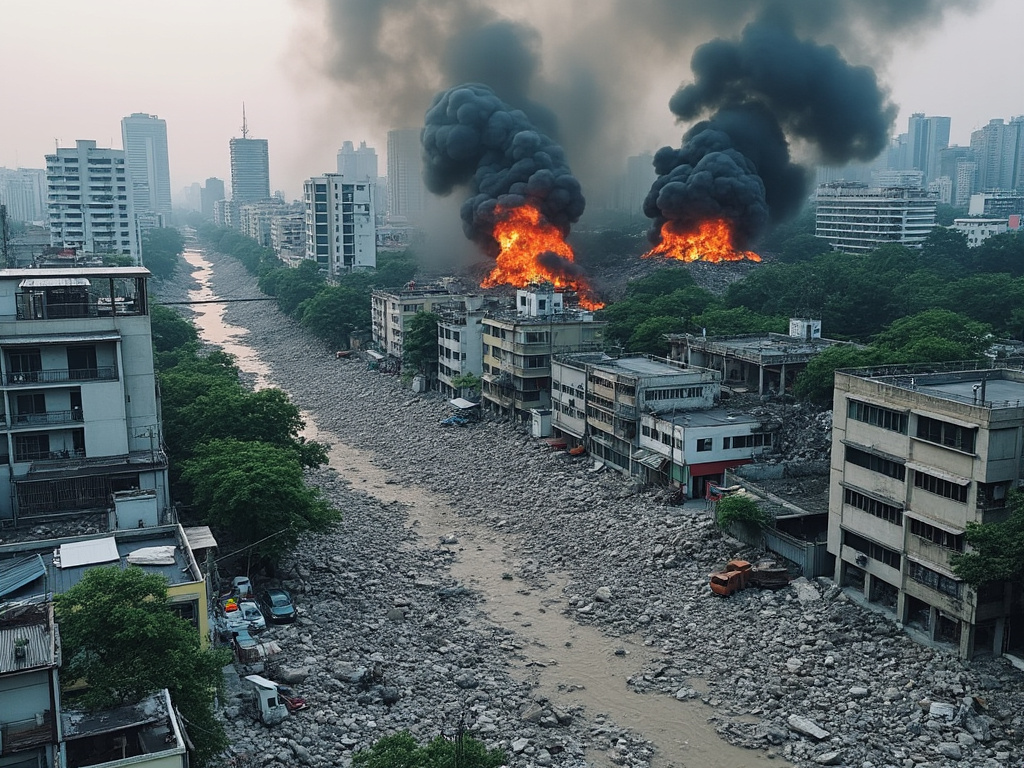
General Romeo Brawner Jnr emphasizes readiness for potential rescue operations as military drills escalate in the region.
General Romeo Brawner Jnr, the chief of the Philippine military, has warned troops to prepare for a possible conflict involving Taiwan amid increasing military tensions with mainland China.
Speaking at the 38th anniversary of the Northern Luzon Command on Tuesday, Brawner highlighted the necessity of planning for a scenario in which the Philippines might need to assist in rescuing approximately 250,000 Filipino overseas workers in Taiwan should conflict arise.
Brawner stated that the Philippines would be 'at the front line' of any such operation.
This directive from the Philippine military comes as Beijing continues its aggressive posture towards Taiwan, which it views as a breakaway province.
The U.S., while not formally recognizing Taiwan as an independent entity, maintains a policy of supporting the island through military arms supplies in opposition to any potential use of force by China.
On the same day, China conducted significant military exercises near Taiwan, as reported by Senior Colonel Shi Yi of the People’s Liberation Army Eastern Command.
These drills are part of an ongoing increase in military activity in the Taiwan Strait, raising alarms across the region.
In a separate but related development, Japan has projected that a massive earthquake along the Nankai Trough could result in up to 298,000 fatalities.
This updated forecast reflects improvements in earthquake-resilient infrastructure since previous estimates of 323,000 deaths made in 2012 and 2013. However, the revised estimate still exceeds the government's goal to reduce potential fatalities by 80 percent before the end of the 2023 financial year.
The Nankai Trough, a significant geological feature, has been identified as a prime location for potentially devastating earthquakes due to the subduction of the Philippine Sea plate beneath Japan’s continental plate.
In response to seismic concerns, Japan plans to allocate a record 20 trillion yen (approximately USD 133 billion) over the next five years to enhance infrastructure resilience against earthquakes.
This financial commitment represents an increase of 5 trillion yen from current initiatives, aiming to fortify critical services such as water and electricity supplies.
In a tragic turn of events, a recent 7.7-magnitude earthquake struck Myanmar and Thailand, resulting in over 1,600 confirmed fatalities.
Rescuers in Mandalay, Myanmar, are engaged in ongoing operations, often using handheld tools to uncover victims trapped beneath debris.
In Thailand, rescue efforts are complicated by collapsed structures, with at least ten reported deaths linked to a construction site disaster in Bangkok.
Following the earthquake, tremors were felt across a broad region, including Laos, China's Yunnan province, and as far south as Ho Chi Minh City in Vietnam.
The earthquakes have prompted widespread international humanitarian responses as rescue operations continue amidst challenging conditions.
Speaking at the 38th anniversary of the Northern Luzon Command on Tuesday, Brawner highlighted the necessity of planning for a scenario in which the Philippines might need to assist in rescuing approximately 250,000 Filipino overseas workers in Taiwan should conflict arise.
Brawner stated that the Philippines would be 'at the front line' of any such operation.
This directive from the Philippine military comes as Beijing continues its aggressive posture towards Taiwan, which it views as a breakaway province.
The U.S., while not formally recognizing Taiwan as an independent entity, maintains a policy of supporting the island through military arms supplies in opposition to any potential use of force by China.
On the same day, China conducted significant military exercises near Taiwan, as reported by Senior Colonel Shi Yi of the People’s Liberation Army Eastern Command.
These drills are part of an ongoing increase in military activity in the Taiwan Strait, raising alarms across the region.
In a separate but related development, Japan has projected that a massive earthquake along the Nankai Trough could result in up to 298,000 fatalities.
This updated forecast reflects improvements in earthquake-resilient infrastructure since previous estimates of 323,000 deaths made in 2012 and 2013. However, the revised estimate still exceeds the government's goal to reduce potential fatalities by 80 percent before the end of the 2023 financial year.
The Nankai Trough, a significant geological feature, has been identified as a prime location for potentially devastating earthquakes due to the subduction of the Philippine Sea plate beneath Japan’s continental plate.
In response to seismic concerns, Japan plans to allocate a record 20 trillion yen (approximately USD 133 billion) over the next five years to enhance infrastructure resilience against earthquakes.
This financial commitment represents an increase of 5 trillion yen from current initiatives, aiming to fortify critical services such as water and electricity supplies.
In a tragic turn of events, a recent 7.7-magnitude earthquake struck Myanmar and Thailand, resulting in over 1,600 confirmed fatalities.
Rescuers in Mandalay, Myanmar, are engaged in ongoing operations, often using handheld tools to uncover victims trapped beneath debris.
In Thailand, rescue efforts are complicated by collapsed structures, with at least ten reported deaths linked to a construction site disaster in Bangkok.
Following the earthquake, tremors were felt across a broad region, including Laos, China's Yunnan province, and as far south as Ho Chi Minh City in Vietnam.
The earthquakes have prompted widespread international humanitarian responses as rescue operations continue amidst challenging conditions.





































